Local Woodworkers Featured At Sheldon Museum
By Phil Gridley & Mary Manly
Vermont has had a long and storied history of artisans and craftsmen producing practical and decorative wood ware and fine furniture. This was especially true in the Champlain Valley and particularly so in Addison County. Products for making and shipping butter included churns, bowls and Scotch Hands for shaping and hardening, decorative stamps for visual appeal and tubs for shipping butter made in Lincoln with spruce staves in various sizes up to fifty pounds.
Carving and whittling of wood was the choice for many artisans like N.F. DeGuise, locally known as “Napoleon”, who was a barber by trade but in addition to cutting hair would carve figures of people seen from his shop window. He did that from shops in Waterbury, Burlington and Bristol. Tom Fitzsimons specialized in carving decorative painted plaques in the Manchester area. Gerald Hannah made carving, what he described as “just plain American characters”, his livelihood with help from his wife who painted the figures. More locally Bill Holway, who carved many of his pieces at the Kennedy Brothers Marketplace in Vergennes, produced a variety of figures from a life-sized bust of an Indian Chief to his specialty, an Ark set with many different beautifully carved animals like giraffes, lions, elephants, etc. The wood most used by these carvers was basswood. Harold Gardner of Starksboro made “marquetry mosaics”. Marquetry is an artistic form of woodworking in which you create mosaics out of various wood veneers.
Furniture makers are also prominent locally and one of note was Edwin T. James of Shoreham. He was a master craftsmen whose shaker style chairs, tables and bedside stands can be found throughout the United States and other countries. Another maker of “primitive contemporary colonial furniture” was John Rowell from Groton who made famous his “Tunbridge Tables”. A style used by the early American pioneers and made from extra-wide thick knotty pine planks.
These historical wood products can be seen as part of:
The Nature of Wood: Vermont Furniture and Woodware, 1790 to the Present Exhibit at the Henry Sheldon Museum, Middlebury, Vt.
In celebration of Vermont wood products, the Henry Sheldon Museum of Vermont History is pleased to present the exhibit The Nature of Wood: Vermont Furniture and Woodware, 1790 to the Present on view through October 23, 2010. Wood is an extraordinarily versatile medium. The Nature of Wood: Vermont Furniture and Woodware combines the Sheldon Museum’s rich collection of locally-crafted furniture with private collections featuring a wide array of Vermont-produced wooden objects spanning the history of the state. The exhibit presents a brief overview of the many beautiful and practical ways Vermonters have made a living creating objects from the rich resources of the Northern Forest.
The Nature of Wood focuses on furniture and wooden objects produced in the lower Champlain Valley. From 1790 to 1855, Middlebury was at the center of a rich furniture making industry, with over fifty craftsmen creating tables, chairs, bureaus, secretaries and other useful wooden objects. Pieces from the Museum’s collection will present the public with a broad range of styles, from country simple to metropolitan chic. In this era, beautiful and practical furniture was being made locally from imported mahogany as well as native pine and maple. In addition to the Sheldon’s collection and the historic woodcrafts, contemporary furniture created by craftsmen who are still inspired by the nature of wood will also be featured. The monthly schedule for the featured contemporary furniture makers is: Douglas Brooks, June; Jim Geier, July; Kit Clark, August; Edward Allen, September; Timothy Clark, October.
Learning Activities for children and adults can be found throughout the Museum. Wooden puzzles, and wooden toys as well as a wooden hand loom for children to use are available in the downstairs activity room. Visitors can pick up a copy of the Nature of Wood scavenger hunt for children at the admission desk or enjoy a game of checkers on the wooden checker board in the upstairs Children’s Hands-on Room.
The Nature of Wood: Vermont Furniture and Woodware, 1790 to the Present has received generous sponsorship from Edgewater Gallery at Middlebury Falls. The exhibit is a 2010 State of Craft Showcase event. The 2010 State of Craft Showcase was organized by the Vermont Crafts Council, in cooperation with the Bennington Museum, the Vermont Folklife Center, and the Vermont Department of Tourism & Marketing.
The Henry Sheldon Museum is located at 1 Park Street in downtown Middlebury across from the Ilsley Library. Museum hours: May 23-October 17: Tues.-Sat. 10 a.m.-5 p.m. and Sun. 1-5 p.m. Fall/Winter/Spring: Tues.-Sat. 10 a.m.-5 p.m. Research Center hours: Tues., Wed., Fri. 1-5 p.m., Thurs. 1-8 p.m. Admission to the Museum is $5 Adults; $3 Youth (6-18); $4.50 Seniors; $12 Family. For more information call 802/388-2117 or visit our website: www.henrysheldonmuseum.org.




